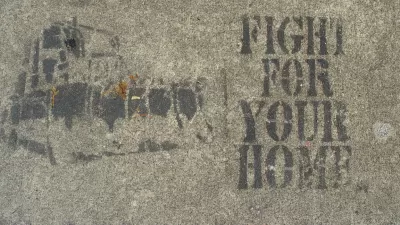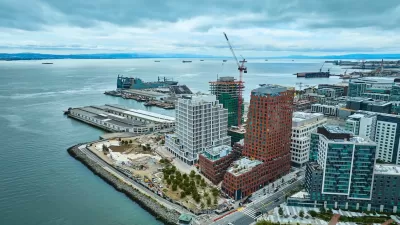The concept of the flâneur was created in the 19th century in response to the encroaching speed and efficiency of the Industrial Age. Can the flâneur now fashion a political response to the Age of the Automobile?

Planetizen blogger Steven Snell launches a new column at Fast Forward Weekly with an urbanist think piece that pits the city of the ambling flâneur against the city of the automobile. The article serves as a call for spatial justice.
First Snell exemplifies the flâneur’s politics by describing the tradition of taking a turtle for a walk. “By taking a turtle for a walk, a flâner disassembles the boring, rational use of urban space; the act avoids the intended logic of the city, which is an outcome of a certain ideology and the period’s political practices. The practices of the flâneur soon became translated into the concept of having a ‘right to the city,’ a theory of spatial justice. And theories in turn prescribed novel, concrete practices to take back the city from the oppressive and discriminatory constructions of modernist city planning.”
Contrast that with the legacy of much 20th century planning and development. “Although the automobile was supposed to be the ultimate form of modernity — individualism, the efficiency of point-to-point convenience — it’s led to urban sprawl (along with psychological, environmental and health implications). It’s led to big-box stores, drive-through coffee shops and ATMs, dispersed communities with often ironic names. It’s led to a city designed around its bullish behaviours. The logic of city planning for the single occupancy vehicle has led to oppressive spaces, spatial injustice.”
Snell points to acts of tactical urbanism and collective action as examples that the world is ready for the flâneur to recover the spaces of the city.
FULL STORY: Taking a turtle for a walk

Trump Administration Could Effectively End Housing Voucher Program
Federal officials are eyeing major cuts to the Section 8 program that helps millions of low-income households pay rent.

Planetizen Federal Action Tracker
A weekly monitor of how Trump’s orders and actions are impacting planners and planning in America.

Ken Jennings Launches Transit Web Series
The Jeopardy champ wants you to ride public transit.

Washington Legislature Passes Rent Increase Cap
A bill that caps rent increases at 7 percent plus inflation is headed to the governor’s desk.

From Planning to Action: How LA County Is Rethinking Climate Resilience
Chief Sustainability Officer Rita Kampalath outlines the County’s shift from planning to implementation in its climate resilience efforts, emphasizing cross-departmental coordination, updated recovery strategies, and the need for flexible funding.

New Mexico Aging Department Commits to Helping Seniors Age ‘In Place’ and ‘Autonomously’ in New Draft Plan
As New Mexico’s population of seniors continues to grow, the state’s aging department is proposing expanded initiatives to help seniors maintain their autonomy while also supporting family caregivers.
Urban Design for Planners 1: Software Tools
This six-course series explores essential urban design concepts using open source software and equips planners with the tools they need to participate fully in the urban design process.
Planning for Universal Design
Learn the tools for implementing Universal Design in planning regulations.
Heyer Gruel & Associates PA
Ada County Highway District
Institute for Housing and Urban Development Studies (IHS)
City of Grandview
Harvard GSD Executive Education
Toledo-Lucas County Plan Commissions
Salt Lake City
NYU Wagner Graduate School of Public Service





























